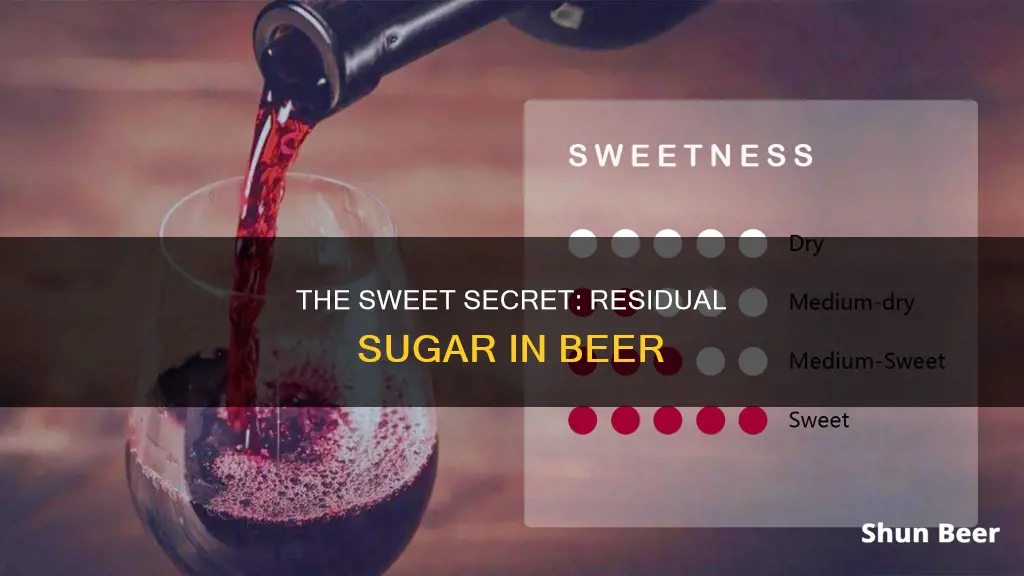
Residual sugar in beer refers to the sugar content that remains after the fermentation process. Sugar is necessary to create alcohol, and while it's not added as an ingredient, it's derived from the processing of grains. The amount of residual sugar in beer depends on the type of beer and the yeast strain used for brewing. Lagers tend to have less residual sugar than ales due to the different yeast strains used. Measuring the exact sugar content in beer is challenging, and standard nutritional labels on alcoholic beverages in the United States do not include sugar content information. However, it's important to note that beer contains carbohydrates, which can impact blood sugar levels, and its alcohol content contributes to the overall calorie intake.
What You'll Learn

Calculating residual sugar percentage
Residual sugar in beer refers to the sugars that are still present after the fermentation process is complete. These sugars are generally derived from malted barley, but brewers may also use adjuncts such as different malted grains, corn, rice, syrup, honey, molasses, or other forms of sugar. The amount of residual sugar in a beer can vary widely, with some beers having less than 1% residual sugar, while others may have up to 10%.
Calculating the residual sugar percentage in beer can be a complex task, and there is no standard formula to determine it. However, there are a few methods and tools that can be used to estimate the residual sugar content:
Using a Brix hydrometer:
The Brix scale is a measure of the percentage of sugar by mass in a solution. A Brix hydrometer can be used to measure the specific gravity of the beer, which can then be converted to a Brix value. However, it's important to note that the presence of alcohol in beer can affect the accuracy of this method.
Final specific gravity:
The residual sugar percentage can also be estimated by calculating the difference between the original specific gravity (OG) and the final specific gravity (FG) of the wort. This method provides an approximation of the sugar content, but it does not account for the type of sugars used or the presence of alcohol.
Online calculators:
There are online calculators, such as Vinocalc and FermCalc, that can be used to estimate residual sugar content. These calculators take into account factors such as original gravity, final gravity, and the impact of alcohol on density.
Laboratory analysis:
For a more accurate measurement, laboratory techniques such as chromatography and refractometry can be used to directly measure the sugar content in the beer. These methods are more complex and may not be accessible to everyone.
It's important to note that the perception of sweetness in beer is not solely based on residual sugar content. Factors such as temperature, carbonation, and bitterness can also influence how sweet a beer tastes. Additionally, not all sugars present in beer contribute to a sweet flavour.
Star Beer's Sugar Content: What You Need to Know
You may want to see also

Beer styles and sugar content
Residual sugars are those that remain in beer after the fermentation process is complete. The amount of residual sugar in a beer varies according to style, with some beers having less than 1% residual sugar by weight, and others nearing 10%.
Beers with a lot of residual sugar will have a fuller body and a sweeter taste, whereas those with less will be drier and have a lighter mouthfeel. The sugars in beer are generally derived from malted barley, but brewers may also use adjuncts such as different malted grains, corn, rice, syrup, honey, or molasses to add more sugar.
Brewers have a lot of control over the sugar profile of their beers and can influence the amount of residual sugar in several ways. For example, they can use sugars that they know yeast will not be able to consume, such as lactose in milk stouts. They can also adjust the conditions during the mash to influence how many of the resulting sugars will be fermentable. Higher saccharification temperatures will result in the production of larger dextrins, which yeasts will not ferment. Brewers can also select yeast strains that will consume more or less of certain sugars.
While the range of residual sugar varies across different beer styles, it is important to note that not all sugars taste sweet. The perception of sweetness is based on several factors, including temperature, carbonation, and bitterness. Beers with high residual sugars rarely taste as sweet as the sweetest wines. However, many beers have enough residual sugar to make them good accompaniments to desserts and digestifs.
When it comes to beer styles, the amount of residual sugar can vary significantly. For example, lambics, some saisons, and other Belgian specialty styles tend to have very low residual sugar content, while barley wines can have much higher levels of residual sugar, approaching 10%.
In terms of popular beer styles, IPAs tend to have higher alcohol, calorie, and carb content, even though they are lighter in colour. Conversely, a dark stout like Guinness can be lower in calories, and a lager is a good choice for a lower-calorie, lower-sugar beer. Sweet-tasting beers tend to contain more residual sugars, which translates to more calories and carbohydrates than their drier counterparts, such as lagers and pale lagers.
Sweetening Success: Corn Sugar for Beer Brewing
You may want to see also

Yeast's role in residual sugar
Yeast plays a crucial role in the beer-making process, specifically in the fermentation stage, where it consumes sugars and produces alcohol, carbonation, and other compounds that give beer its distinct flavour. The most commonly used yeast in beer production is the Saccharomyces genus, which includes two specific species: lager yeast (Saccharomyces pastorianus) and ale yeast (Saccharomyces cerevisiae).
Saccharomyces cerevisiae, or ale yeast, is a top-fermenting yeast that rises to the top of the beer during fermentation and operates best at higher temperatures, ranging from 50°F to 70°F. This versatile yeast is responsible for a diverse range of beer styles, such as stouts, IPAs, saisons, and witbiers. On the other hand, Saccharomyces pastorianus, or lager yeast, is a bottom-fermenting yeast that sits at the bottom of the tank during fermentation and prefers lower temperatures between 48°F and 58°F. Lager yeast is the most commonly used yeast globally and is essential for producing popular beer styles like Pilsners, lagers, and bocks.
During fermentation, yeast consumes carbohydrates in a specific sequence: monosaccharides (glucose and fructose), disaccharides (sucrose and maltose), and trisaccharide maltotriose. A small amount of maltotriose is used to form reserve polysaccharides like glycogen and trehalose. Additionally, amino acids assimilated by the yeast are utilised for protein, enzyme, and new cell synthesis. The by-products of this process, such as carbonyl compounds, higher alcohols, esters, organic acids, and sulphur-containing compounds, significantly influence the flavour profile and quality of the beer.
Brewers have a wide range of options when it comes to yeast selection, with hundreds or even thousands of strains available. This variety allows brewers to create beers with different characteristics, such as higher or lower alcohol content, and desired flavour profiles. For instance, lactose, a non-fermentable sugar used in brewing milk stouts, results in a sweeter beer with a fuller body. Brewers can also adjust factors like saccharification temperature to influence the production of larger dextrins, which yeasts will not ferment, resulting in a beer with a lighter mouthfeel and reduced sweetness.
In recent years, there has been a growing interest in using non-Saccharomyces yeasts, which possess unique enzymatic activities that contribute to enhanced aromatic complexity. These yeasts, often found in spontaneous beer fermentations, can be used as single starters or in mixed cultures with Saccharomyces strains to create beers with distinctive sensory profiles. For instance, Brettanomyces bruxellensis, a non-Saccharomyces yeast, produces esters like ethyl acetate and ethyl lactate, contributing to the sour flavour characteristic of lambic beer.
Wheat Beer's Sweet Secret: Sugar Content Explained
You may want to see also

Measuring residual sugar
Residual sugar in beer refers to the sugars that are still present after the fermentation process is complete. Measuring residual sugar in beer can be tricky, and there is no straightforward formula to calculate the exact amount. However, here are some methods and techniques that can be used to estimate or indirectly measure the residual sugar content:
Final Gravity and Original Gravity:
To determine residual sugar, you need to know the final gravity (FG) of the wort before fermentation and the original gravity (OG). The difference between OG and FG will give you the Alcohol By Volume (ABV) of the beer. Specific gravity is measured in kg/(m^3). While this doesn't directly give you the residual sugar content, it provides an indication of the calories left in the beer. There are online calculators available to estimate the residual sugar content based on OG and FG values.
Hydrometer:
A hydrometer measures the specific gravity of your wort and finished beer. You can take readings before and after fermentation to estimate the sugar content. There are online calculators that use the OG and FG values obtained from a hydrometer to estimate the ABV and, indirectly, the residual sugar content.
Refractometer:
A refractometer is an optical device that measures the specific gravity of your beer by sampling a small amount of liquid. Most brewing refractometers measure in Brix, a scale commonly used by winemakers. The readings need to be converted to standard specific gravity or Plato scales, as wort has different reflective properties than plain sugar water. While refractometers are useful for measuring original gravity, they are less accurate for measuring final gravity in beer due to the presence of alcohol.
Pycnometer:
A pycnometer is a precise tool for measuring specific gravity. It involves calibrating the pycnometer with distilled water at a specific temperature and then measuring the weight of your wort and fermented beer at the same temperature. This method provides OG and FG values, which can be used to estimate ABV and residual sugar content.
Distillation:
You can measure residual sugar through a distillation process. Take a measured volume of beer (e.g., 100ml) and distill it at a specific temperature (e.g., 85°C) for a set time (e.g., 20-30 minutes). This process separates the alcohol, and the remaining content will be a sugar solution with traces of barley. You can then measure the Brix of this solution to estimate the residual sugar content.
Scientific Methods:
There are several scientific methods described in a 1977 paper titled "Measurement of Carbohydrates in Wort and Beer" by G. K. Buckee and R. Haroitt. These methods include reductometry, colorimetry, enzymic procedures, automated analyses, chromatography, and high-performance liquid chromatography. These techniques are generally more complex and may not be feasible for the average person.
It is important to note that the type of sugars used and the specific recipe can impact the accuracy of residual sugar measurements. Additionally, the perception of sweetness in beer is influenced by factors such as temperature, carbonation, and bitterness, and not all sugars taste sweet.
St. Pauli Girl NA Beer: Sugar Content Analysis
You may want to see also

Beer gravity and sugar content
Beer is made from grains, spices, yeast, and water. Barley and wheat are the most commonly used grains, while hops are the principal flavouring spice. The brewing process consists of malting, mashing, boiling, fermentation, and maturation.
The Role of Sugar in Beer
Sugar is essential in the beer-making process, but it is not added as an ingredient. Instead, it comes from the processing of the grains and is then fermented by yeast to produce alcohol. The yeast ferments the wort, converting its sugars into alcohol and carbon dioxide. As the yeast ferments the wort, its sugar content decreases while its alcohol content increases.
Beer Gravity
Beer gravity refers to the density of the wort relative to water at various stages of fermentation, and it is mostly determined by sugar content. A wort with a high sugar concentration is called a high-gravity wort. Beers have an initial and final gravity, and the difference between the two indicates the amount of sugar that was converted into alcohol.
Measuring Sugar Content in Beer
The sugar content in beer is measured using a hydrometer or refractometer. These devices determine the "final gravity" of the beer, or how much sugar is left over. A "high-gravity" beer will start with a lot of sugar, resulting in a highly alcoholic beverage.
Original Gravity vs. Final Gravity
The total sugar content in the beer before fermentation is called the "original gravity," while the total sugar content after fermentation is called the "final gravity." By comparing these two values, we can determine both the alcohol content and the sugar content of the final product. For example, a beer with an original gravity of 1.15 and a final gravity of 1.00 would have an alcohol content of over 10%.
Types of Sugar in Beer
The most common type of sugar in beer is maltose, which is made from two glucose molecules. Maltose and other simple sugars comprise about 80% of the wort's fermentable sugar content, while the remaining 20% consists of oligosaccharides, which yeast does not ferment. The body cannot digest oligosaccharides, so they are considered calorie-free and act as prebiotic fibres.
Sugar Content in Different Beer Styles
The sugar content in beer can vary depending on the style and the ingredients used. For example, light beers tend to have slightly higher sugar content than regular beers due to differences in their fermentation process. Non-alcoholic beers have the highest sugar content because none of the wort's sugar is converted into alcohol.
Beer and Blood Sugar
While beer may not have a high sugar content, it is an alcoholic drink, and as such, it can lower blood sugar levels. Alcohol impairs sugar metabolism, which can lead to hypoglycaemia or low blood sugar levels. Therefore, it is generally recommended to consume alcohol with a carb-containing meal.
Beer vs. Chardonnay: Which Has More Sugar?
You may want to see also
Frequently asked questions
Residual sugar in beer refers to the sugar left over after the fermentation process. Sugar is necessary to create alcohol, and yeast consumes sugar and excretes alcohol as a byproduct.
Residual sugar in beer is measured using a hydrometer or refractometer.
The amount of residual sugar in beer varies depending on the style and type of beer. Regular beer typically contains 12.8 grams of carbohydrates and no grams of sugar, while light beer contains 5.9 grams of carbohydrates and 0.3 grams of sugar.







